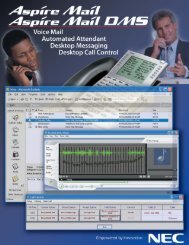KX-TDA 50 Brochure - Kingtechnologies.com
KX-TDA 50 Brochure - Kingtechnologies.com
KX-TDA 50 Brochure - Kingtechnologies.com
You also want an ePaper? Increase the reach of your titles
YUMPU automatically turns print PDFs into web optimized ePapers that Google loves.
Account Codes<br />
Account codes can help manage your telephone expenses<br />
by identifying in<strong>com</strong>ing and outgoing external calls for<br />
accounting and billing purposes. The system can be<br />
programmed to force the use of an account code or not.<br />
The account code is appended to the Station Message Detail<br />
Recording (SMDR), which is very useful for billing back clients,<br />
or to simply keep a record of the time spent on the<br />
telephone for a specific project.<br />
Direct Inward System Access (DISA)<br />
The <strong>KX</strong>-<strong>TDA</strong><strong>50</strong> allows an outside caller to access specific<br />
system features without operator assistance, as if the caller<br />
was using an extension in the system. The outside caller<br />
can have direct access to the following features: single-digit<br />
access to extensions, outside party calling, inter<strong>com</strong> calling<br />
to an extension, modem (for remote system administration),<br />
external paging (for TAFAS) and extension group. Additionally,<br />
callers can be required to dial a security code to access<br />
extensions or the system’s outside lines.<br />
With the optional <strong>KX</strong>-<strong>TDA</strong>5191 2-Channel Message Card,<br />
DISA also offers a built-in Auto Attendant. With the Auto<br />
Attendant you can record a preprogrammed message for<br />
in<strong>com</strong>ing calls. This message would direct callers to press<br />
a certain number for the extension they wish to reach. By<br />
doing so, the Auto Attendant can route callers to their desired<br />
location through answering a few preprogrammed questions.<br />
This will save time for both the caller and those who would<br />
otherwise have to direct call traffic.<br />
Call Forwarding<br />
There are four types of call forwarding – all calls, busy, no<br />
answer and busy/no answer. With these four options your<br />
calls can be forwarded whenever and however you like.<br />
And, all four options can be established by dialing a code<br />
or programming a feature key to forward your calls to a<br />
specific destination. You can also forward group calls as well<br />
as, internal and external calls that can be forwarded to an<br />
internal extension or an external telephone number. Each call<br />
can be forwarded up to four times.<br />
In<strong>com</strong>ing inter<strong>com</strong> and transferred calls to your extension can<br />
easily be forwarded to you outside the office. You can now<br />
forward your calls to your cell phone, another location, or<br />
even your home. Calls can reach you almost anywhere in the<br />
world, 24 hours a day, 7 days a week. Another great feature is<br />
“follow-me” programming, which allows you to remotely set<br />
Call Forwarding from another phone within your organization,<br />
so calls to your extension will reach you while you roam.<br />
Caller ID/Call Logging<br />
Caller ID displays the in<strong>com</strong>ing caller’s phone number, or<br />
name and number (if provided by the local phone <strong>com</strong>pany),<br />
when used with a Panasonic system display phone. Calls<br />
that are answered or not answered that are directed to a<br />
group or an individual extension can be logged, and the<br />
total calls that can be logged are assignable through system<br />
programming on a per extension basis. Logged calls can be<br />
called back by going off-hook while viewing the display and<br />
pushing the redial key. There are also up to 1000 programmable<br />
entries of name and number for Caller ID service that can be<br />
administered by either the user or the system programmer.




